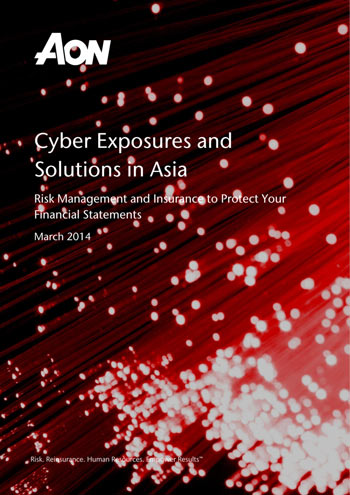Aon: Cyber exposures and solutions in Asia
April 24 2015
Successful businesses throughout Asia use technology to increase sales, maximise efficiency and reduce expenses. Evolving technologies such as cloud computing, mobile devices, social media and “big data” analytics have helped them become more competitive in the global economy.
Meanwhile, the array of threats to cyber security continues to grow and evolve, and Asian companies are considered by many to be the most likely targets in the world. Cyber theft, fraud, sabotage, espionage, and hacking (including from governments) are more frequent in the social media age and the associated costs with information security breaches are increasing for entities in every industry sector – from retail, financial institutions, healthcare, hospitality, media, communications, technology, consulting and professional services to manufacturing, government/public sector, energy/utilities, critical infrastructure and transportation.
The legal exposure, reputational harm and business interruptions that may result can wreak havoc on a company’s bottom line.
Global executives meeting at the Word Economic Forum in Davos, Switzerland in January 2014 addressed the increasing costs of data theft and the difficulty in countering criminals who are intent on stealing data.1 Citing security breaches such as those at Japan based Mt. Gox, the largest Bitcoin exchange, and Target Corporation, the second largest U.S. retailer: the Davos executives noted the serious risk and high cost of security breaches, and expressed concern that further major disruptions due to security breaches could become commonplace.
“Technology is going to create significant opportunities, but how we as humans adapt to the changes will be very important.”
The continent of Asia technically encompasses a widely varied landscape with dramatically diverse legal systems and commercial environments. As of March 1, 2014, an increasing number of these countries have some type of privacy, data security, cross-border transfer or other breach disclosure law. This paper attempts to:
- Outline some general 2014 cyber exposure and solution trends applicable to most Asian countries
- Explore in-depth cyber issues specific to Malaysia, Singapore, Hong Kong and South Korea
- Offer a risk management process to identify, understand, quantify, mitigate, and transfer cyber risks
-Aon
-
QBE’s Hammond on transformation and growth
- July 2
The Asia chief executive discusses Covid-19, going digital and restructuring.
-
Swiss Re: Nat cats and man-made disasters in 2018
- April 10
Climate change, increased urbanisation and a growing concentration of assets were on the risk agenda for 2018.
-
Willis Towers Watson: 2019 Asia Market Report
- March 19
Economic uncertainty, more complex risks and tighter underwriting are all influencing Asia's markets.
-
Peak Re: Emerging Asia’s life and health opportunity
- March 11
Life and health premium growth is expected to outpace GDP gains in eight Asian markets.
-
Allianz General | Allianz General combines innovative protection solutions while powering social good to lead Malaysian market
The insurer proactively addresses emerging risks and evolving customer protection needs while giving back to the community.
-
Sedgwick | Asia’s Energy Transformation – Balancing Growth, Risk and Renewables
Energy market presents unique risks, especially in a region which includes China and Japan as well as developing nations like Vietnam and the Philippines.
-
Beazley | Turbulent Waters: the maritime energy transition challenge
Businesses are facing a complex transition to non-carbon energy sources amid a push to achieve net-zero emissions for the marine sector by 2050.
-
Aon | Navigating shifts in the global and Asia insurance markets
Neelay Patel, Aon head of growth for Asia, says the market in Asia is at an ‘interesting stage of the cycle’.

